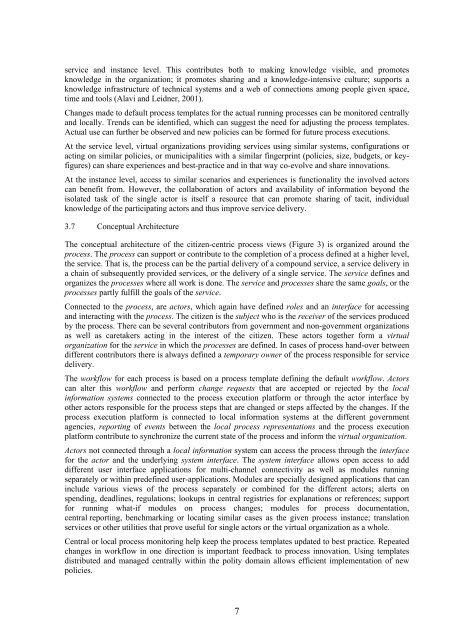Multi-channel provisioning of public services - Department of ...
Multi-channel provisioning of public services - Department of ...
Multi-channel provisioning of public services - Department of ...
Create successful ePaper yourself
Turn your PDF publications into a flip-book with our unique Google optimized e-Paper software.
service and instance level. This contributes both to making knowledge visible, and promotes<br />
knowledge in the organization; it promotes sharing and a knowledge-intensive culture; supports a<br />
knowledge infrastructure <strong>of</strong> technical systems and a web <strong>of</strong> connections among people given space,<br />
time and tools (Alavi and Leidner, 2001).<br />
Changes made to default process templates for the actual running processes can be monitored centrally<br />
and locally. Trends can be identified, which can suggest the need for adjusting the process templates.<br />
Actual use can further be observed and new policies can be formed for future process executions.<br />
At the service level, virtual organizations providing <strong>services</strong> using similar systems, configurations or<br />
acting on similar policies, or municipalities with a similar fingerprint (policies, size, budgets, or keyfigures)<br />
can share experiences and best-practice and in that way co-evolve and share innovations.<br />
At the instance level, access to similar scenarios and experiences is functionality the involved actors<br />
can benefit from. However, the collaboration <strong>of</strong> actors and availability <strong>of</strong> information beyond the<br />
isolated task <strong>of</strong> the single actor is itself a resource that can promote sharing <strong>of</strong> tacit, individual<br />
knowledge <strong>of</strong> the participating actors and thus improve service delivery.<br />
3.7 Conceptual Architecture<br />
The conceptual architecture <strong>of</strong> the citizen-centric process views (Figure 3) is organized around the<br />
process. The process can support or contribute to the completion <strong>of</strong> a process defined at a higher level,<br />
the service. That is, the process can be the partial delivery <strong>of</strong> a compound service, a service delivery in<br />
a chain <strong>of</strong> subsequently provided <strong>services</strong>, or the delivery <strong>of</strong> a single service. The service defines and<br />
organizes the processes where all work is done. The service and processes share the same goals, or the<br />
processes partly fulfill the goals <strong>of</strong> the service.<br />
Connected to the process, are actors, which again have defined roles and an interface for accessing<br />
and interacting with the process. The citizen is the subject who is the receiver <strong>of</strong> the <strong>services</strong> produced<br />
by the process. There can be several contributors from government and non-government organizations<br />
as well as caretakers acting in the interest <strong>of</strong> the citizen. These actors together form a virtual<br />
organization for the service in which the processes are defined. In cases <strong>of</strong> process hand-over between<br />
different contributors there is always defined a temporary owner <strong>of</strong> the process responsible for service<br />
delivery.<br />
The workflow for each process is based on a process template defining the default workflow. Actors<br />
can alter this workflow and perform change requests that are accepted or rejected by the local<br />
information systems connected to the process execution platform or through the actor interface by<br />
other actors responsible for the process steps that are changed or steps affected by the changes. If the<br />
process execution platform is connected to local information systems at the different government<br />
agencies, reporting <strong>of</strong> events between the local process representations and the process execution<br />
platform contribute to synchronize the current state <strong>of</strong> the process and inform the virtual organization.<br />
Actors not connected through a local information system can access the process through the interface<br />
for the actor and the underlying system interface. The system interface allows open access to add<br />
different user interface applications for multi-<strong>channel</strong> connectivity as well as modules running<br />
separately or within predefined user-applications. Modules are specially designed applications that can<br />
include various views <strong>of</strong> the process separately or combined for the different actors; alerts on<br />
spending, deadlines, regulations; lookups in central registries for explanations or references; support<br />
for running what-if modules on process changes; modules for process documentation,<br />
central reporting, benchmarking or locating similar cases as the given process instance; translation<br />
<strong>services</strong> or other utilities that prove useful for single actors or the virtual organization as a whole.<br />
Central or local process monitoring help keep the process templates updated to best practice. Repeated<br />
changes in workflow in one direction is important feedback to process innovation. Using templates<br />
distributed and managed centrally within the polity domain allows efficient implementation <strong>of</strong> new<br />
policies.<br />
7
















